现代语言学 简答整理
【简答题】语言学纲要
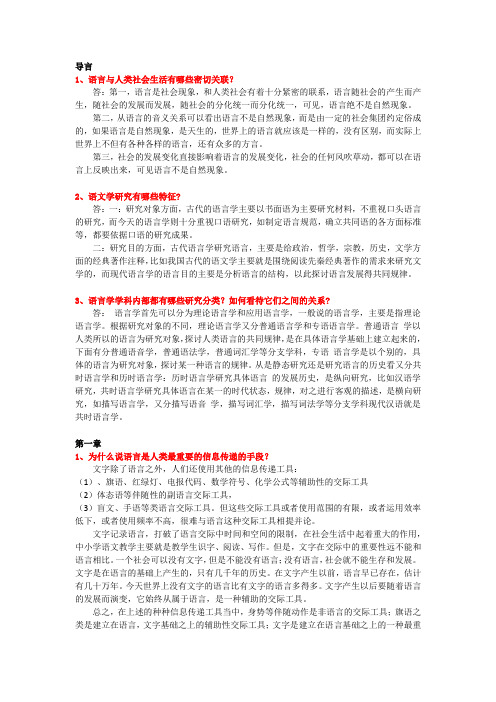
导言1、语言与人类社会生活有哪些密切关联?答:第一,语言是社会现象,和人类社会有着十分紧密的联系,语言随社会的产生而产生,随社会的发展而发展,随社会的分化统一而分化统一,可见,语言绝不是自然现象。
第二,从语言的音义关系可以看出语言不是自然现象,而是由一定的社会集团约定俗成的,如果语言是自然现象,是天生的,世界上的语言就应该是一样的,没有区别,而实际上世界上不但有各种各样的语言,还有众多的方言。
第三,社会的发展变化直接影响着语言的发展变化,社会的任何风吹草动,都可以在语言上反映出来,可见语言不是自然现象。
2、语文学研究有哪些特征?答:一:研究对象方面,古代的语言学主要以书面语为主要研究材料,不重视口头语言的研究,而今天的语言学则十分重视口语研究,如制定语言规范,确立共同语的各方面标准等,都要依据口语的研究成果。
二:研究目的方面,古代语言学研究语言,主要是给政治,哲学,宗教,历史,文学方面的经典著作注释,比如我国古代的语文学主要就是围绕阅读先秦经典著作的需求来研究文学的,而现代语言学的语言目的主要是分析语言的结构,以此探讨语言发展得共同规律。
3、语言学学科内部都有哪些研究分类?如何看待它们之间的关系?答:语言学首先可以分为理论语言学和应用语言学,一般说的语言学,主要是指理论语言学。
根据研究对象的不同,理论语言学又分普通语言学和专语语言学。
普通语言学以人类所以的语言为研究对象,探讨人类语言的共同规律,是在具体语言学基础上建立起来的,下面有分普通语音学,普通语法学,普通词汇学等分支学科,专语语言学是以个别的,具体的语言为研究对象,探讨某一种语言的规律。
从是静态研究还是研究语言的历史看又分共时语言学和历时语言学:历时语言学研究具体语言的发展历史,是纵向研究,比如汉语学研究,共时语言学研究具体语言在某一的时代状态,规律,对之进行客观的描述,是横向研究,如描写语言学,又分描写语音学,描写词汇学,描写词法学等分支学科现代汉语就是共时语言学。
自己整理的简答(语言学概论)
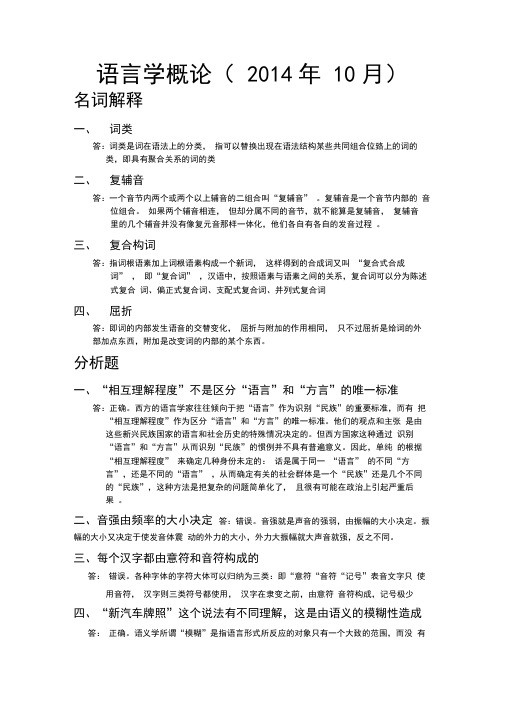
语言学概论(2014年10月)名词解释一、词类答:词类是词在语法上的分类,指可以替换出现在语法结构某些共同组合位臵上的词的类,即具有聚合关系的词的类二、复辅音答:一个音节内两个或两个以上辅音的二组合叫“复辅音” 。
复辅音是一个音节内部的音位组合。
如果两个辅音相连,但却分属不同的音节,就不能算是复辅音,复辅音里的几个辅音并没有像复元音那样一体化,他们各自有各自的发音过程。
三、复合构词答:指词根语素加上词根语素构成一个新词,这样得到的合成词又叫“复合式合成词” ,即“复合词” ,汉语中,按照语素与语素之间的关系,复合词可以分为陈述式复合词、偏正式复合词、支配式复合词、并列式复合词四、屈折答:即词的内部发生语音的交替变化,屈折与附加的作用相同,只不过屈折是给词的外部加点东西,附加是改变词的内部的某个东西。
分析题一、“相互理解程度”不是区分“语言”和“方言”的唯一标准答:正确。
西方的语言学家往往倾向于把“语言”作为识别“民族”的重要标准,而有把“相互理解程度”作为区分“语言”和“方言”的唯一标准。
他们的观点和主张是由这些新兴民族国家的语言和社会历史的特殊情况决定的。
但西方国家这种通过识别“语言”和“方言”从而识别“民族”的惯例并不具有普遍意义。
因此,单纯的根据“相互理解程度” 来确定几种身份未定的:话是属于同一“语言” 的不同“方言”,还是不同的“语言” ,从而确定有关的社会群体是一个“民族”还是几个不同的“民族”,这种方法是把复杂的问题简单化了,且很有可能在政治上引起严重后果。
二、音强由频率的大小决定答:错误。
音强就是声音的强弱,由振幅的大小决定。
振幅的大小又决定于使发音体震动的外力的大小,外力大振幅就大声音就强,反之不同。
三、每个汉字都由意符和音符构成的答:错误。
各种字体的字符大体可以归纳为三类:即“意符“音符“记号”表音文字只使用音符,汉字则三类符号都使用,汉字在隶变之前,由意符音符构成,记号极少四、“新汽车牌照”这个说法有不同理解,这是由语义的模糊性造成答:正确。
语言学知识点总结
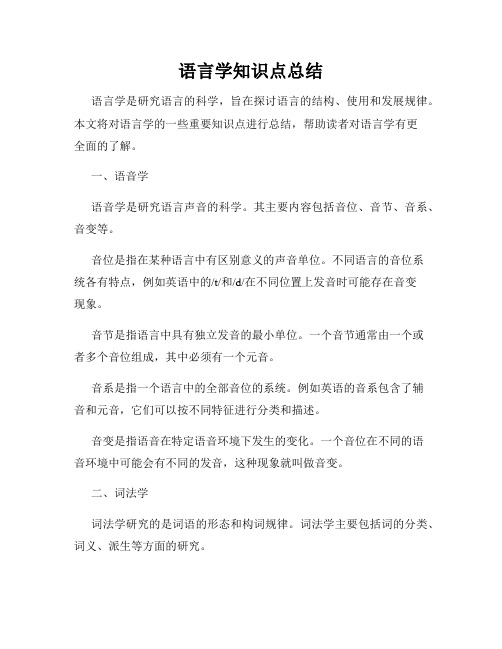
语言学知识点总结语言学是研究语言的科学,旨在探讨语言的结构、使用和发展规律。
本文将对语言学的一些重要知识点进行总结,帮助读者对语言学有更全面的了解。
一、语音学语音学是研究语言声音的科学。
其主要内容包括音位、音节、音系、音变等。
音位是指在某种语言中有区别意义的声音单位。
不同语言的音位系统各有特点,例如英语中的/t/和/d/在不同位置上发音时可能存在音变现象。
音节是指语言中具有独立发音的最小单位。
一个音节通常由一个或者多个音位组成,其中必须有一个元音。
音系是指一个语言中的全部音位的系统。
例如英语的音系包含了辅音和元音,它们可以按不同特征进行分类和描述。
音变是指语音在特定语音环境下发生的变化。
一个音位在不同的语音环境中可能会有不同的发音,这种现象就叫做音变。
二、词法学词法学研究的是词语的形态和构词规律。
词法学主要包括词的分类、词义、派生等方面的研究。
词的分类根据不同的分类标准,词可以分为名词、动词、形容词、副词等等。
不同类别的词在语法和词义上有各自的特点。
词义是指词的意义。
一个词可以有多个意义,根据上下文来理解具体的意思。
语境对于词义的理解非常重要。
派生是指通过添加前缀、后缀或者改变词形来创造新词。
派生是词语演化和发展的重要手段。
三、句法学句法学是研究句子结构和语法规则的学科。
它关注的是句子中词语的组织和句子之间的关系。
短语结构是指词语在句子中的组织形式。
一个句子可以被分解为若干个短语,它们按照一定的顺序组成句子的结构。
句法关系是指不同短语在句子中的语法关系。
例如主谓关系、动宾关系等。
句法关系对句子的理解和翻译都非常重要。
四、语义学语义学研究的是词语和句子的意义。
它试图解释语言中的概念和关系,了解句子的真实含义。
词义是词语的基本意思,通过词的定义、例句和上下文来解释词的意思。
句义是指句子的意义。
句意可以通过句子的结构和上下文来理解。
语用学研究的是语言使用的具体情境和交际功能。
它关注语言如何在特定环境中进行交流。
现代语言学 复习要点
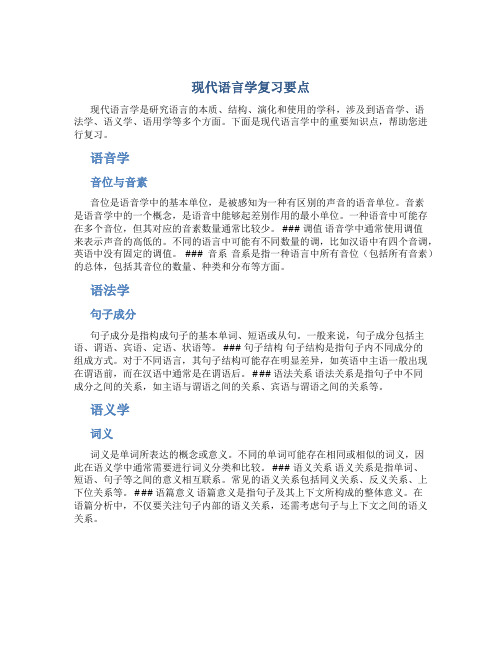
现代语言学复习要点现代语言学是研究语言的本质、结构、演化和使用的学科,涉及到语音学、语法学、语义学、语用学等多个方面。
下面是现代语言学中的重要知识点,帮助您进行复习。
语音学音位与音素音位是语音学中的基本单位,是被感知为一种有区别的声音的语音单位。
音素是语音学中的一个概念,是语音中能够起差别作用的最小单位。
一种语音中可能存在多个音位,但其对应的音素数量通常比较少。
### 调值语音学中通常使用调值来表示声音的高低的。
不同的语言中可能有不同数量的调,比如汉语中有四个音调,英语中没有固定的调值。
### 音系音系是指一种语言中所有音位(包括所有音素)的总体,包括其音位的数量、种类和分布等方面。
语法学句子成分句子成分是指构成句子的基本单词、短语或从句。
一般来说,句子成分包括主语、谓语、宾语、定语、状语等。
### 句子结构句子结构是指句子内不同成分的组成方式。
对于不同语言,其句子结构可能存在明显差异,如英语中主语一般出现在谓语前,而在汉语中通常是在谓语后。
### 语法关系语法关系是指句子中不同成分之间的关系,如主语与谓语之间的关系、宾语与谓语之间的关系等。
语义学词义词义是单词所表达的概念或意义。
不同的单词可能存在相同或相似的词义,因此在语义学中通常需要进行词义分类和比较。
### 语义关系语义关系是指单词、短语、句子等之间的意义相互联系。
常见的语义关系包括同义关系、反义关系、上下位关系等。
### 语篇意义语篇意义是指句子及其上下文所构成的整体意义。
在语篇分析中,不仅要关注句子内部的语义关系,还需考虑句子与上下文之间的语义关系。
语用学言语行为言语行为是指言语交流过程中所体现的具体行为,如陈述、命令、请求、批评等。
不同类型的言语行为具有不同的功能和表达方式。
### 语用礼貌语用礼貌是指在言语交际过程中对他人尊重、友好的表达方式。
常见的语用礼貌策略包括委婉语、礼貌用语、双重否定等。
### 上下文依存言语交际过程中,具体表达的含义通常需要依赖于上下文信息。
语言学概论单选、多选、名词解释、简答、论述、分析
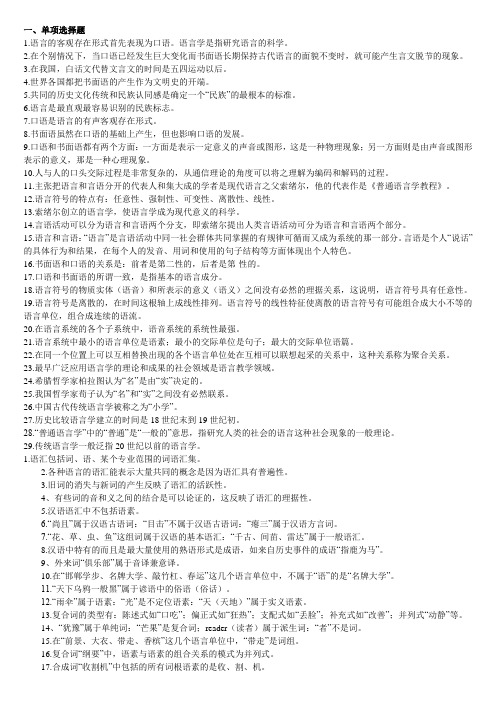
一、单项选择题1.语言的客观存在形式首先表现为口语。
语言学是指研究语言的科学。
2.在个别情况下,当口语已经发生巨大变化而书面语长期保持古代语言的面貌不变时,就可能产生言文脱节的现象。
3.在我国,白话文代替文言文的时间是五四运动以后。
4.世界各国都把书面语的产生作为文明史的开端。
5.共同的历史文化传统和民族认同感是确定一个“民族”的最根本的标准。
6.语言是最直观最容易识别的民族标志。
7.口语是语言的有声客观存在形式。
8.书面语虽然在口语的基础上产生,但也影响口语的发展。
9.口语和书面语都有两个方面:一方面是表示一定意义的声音或图形,这是一种物理现象;另一方面则是由声音或图形表示的意义,那是一种心理现象。
10.人与人的口头交际过程是非常复杂的,从通信理论的角度可以将之理解为编码和解码的过程。
11.主张把语言和言语分开的代表人和集大成的学者是现代语言之父索绪尔,他的代表作是《普通语言学教程》。
12.语言符号的特点有:任意性、强制性、可变性、离散性、线性。
13.索绪尔创立的语言学,使语言学成为现代意义的科学。
14.言语活动可以分为语言和言语两个分支,即索绪尔提出人类言语活动可分为语言和言语两个部分。
15.语言和言语:“语言”是言语活动中同一社会群体共同掌握的有规律可循而又成为系统的那一部分。
言语是个人“说话”的具体行为和结果,在每个人的发音、用词和使用的句子结构等方面体现出个人特色。
16.书面语和口语的关系是:前者是第二性的,后者是第-性的。
17.口语和书面语的所谓一致,是指基本的语言成分。
18.语言符号的物质实体(语音)和所表示的意义(语义)之间没有必然的理据关系,这说明,语言符号具有任意性。
19.语言符号是离散的,在时间这根轴上成线性排列。
语言符号的线性特征使离散的语言符号有可能组合成大小不等的语言单位,组合成连续的语流。
20.在语言系统的各个子系统中,语音系统的系统性最强。
21.语言系统中最小的语言单位是语素;最小的交际单位是句子;最大的交际单位语篇。
语言学概论简答题整理
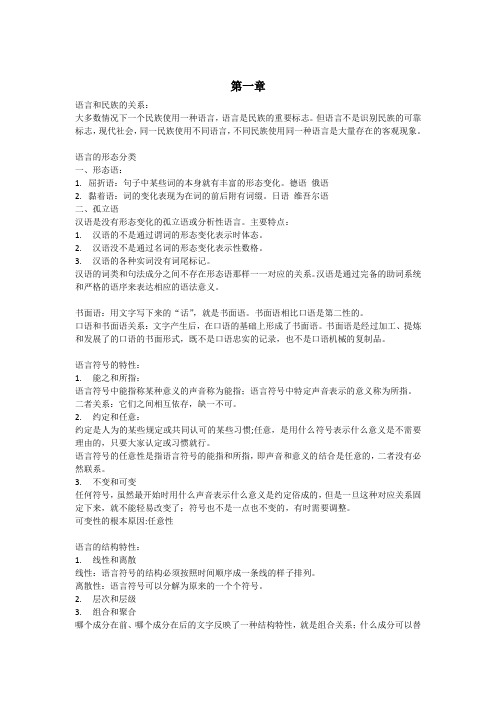
第一章语言和民族的关系:大多数情况下一个民族使用一种语言,语言是民族的重要标志。
但语言不是识别民族的可靠标志,现代社会,同一民族使用不同语言,不同民族使用同一种语言是大量存在的客观现象。
语言的形态分类一、形态语:1.屈折语:句子中某些词的本身就有丰富的形态变化。
德语俄语2.黏着语:词的变化表现为在词的前后附有词缀。
日语维吾尔语二、孤立语汉语是没有形态变化的孤立语或分析性语言。
主要特点:1.汉语的不是通过谓词的形态变化表示时体态。
2.汉语没不是通过名词的形态变化表示性数格。
3.汉语的各种实词没有词尾标记。
汉语的词类和句法成分之间不存在形态语那样一一对应的关系。
汉语是通过完备的助词系统和严格的语序来表达相应的语法意义。
书面语:用文字写下来的“话”,就是书面语。
书面语相比口语是第二性的。
口语和书面语关系:文字产生后,在口语的基础上形成了书面语。
书面语是经过加工、提炼和发展了的口语的书面形式,既不是口语忠实的记录,也不是口语机械的复制品。
语言符号的特性:1.能之和所指:语言符号中能指称某种意义的声音称为能指;语言符号中特定声音表示的意义称为所指。
二者关系:它们之间相互依存,缺一不可。
2.约定和任意:约定是人为的某些规定或共同认可的某些习惯;任意,是用什么符号表示什么意义是不需要理由的,只要大家认定或习惯就行。
语言符号的任意性是指语言符号的能指和所指,即声音和意义的结合是任意的,二者没有必然联系。
3.不变和可变任何符号,虽然最开始时用什么声音表示什么意义是约定俗成的,但是一旦这种对应关系固定下来,就不能轻易改变了;符号也不是一点也不变的,有时需要调整。
可变性的根本原因:任意性语言的结构特性:1.线性和离散线性:语言符号的结构必须按照时间顺序成一条线的样子排列。
离散性:语言符号可以分解为原来的一个个符号。
2.层次和层级3.组合和聚合哪个成分在前、哪个成分在后的文字反映了一种结构特性,就是组合关系;什么成分可以替换出现在某个位置上的问题反映了一种结构特性,是聚合关系。
00830现代语言学复习资料

现代语言学复习资料教材购买:第一章绪论?. , .. (普通语言学), , . (语音学). (音系学). (形态学). (句法学). (语义学). (语用学). (社会语言学). (心理语言学)( ) . (应用语言学), , ., (人类语言学) , (神经语言学) , (数字语言学) . (计算机语言学), , , ..., “” .; . , .., .:. ;. ;. , , .[ə'ə]. ., .. , .语言能力和语言运用. ’.’ , . .?“”“”“” ., , ., ...)., . ., . , . .), .), , , . , , . . ), , . . , .), , .**********************************音系学., . . “” ., .(语言的声音媒介) .(语音).. ?;’ .(发音语音学), ’ . .(听觉语音学),’ . .(声学语音学), . ..咽腔口腔鼻腔语音解剖图发音器官图. (字母符号) , (宽式音标). (变音符号), (窄式音标). 音的比较[]是不送气音,在宽式音标中不作标示,写作:[]音的比较在元音前,叫清晰音,在宽式音标中不作标示,写作:[][][][],在窄式音标中加变音符号[])塞音或爆破音: [] [] [] [] [] []擦音:[] [] [] [] [] [] [] [] []塞擦音:[][][] [][] [] [][] [])[] [] [] [][] [][] [][] [] [] [] [] [] [][][][][][] [] [][])前元音:[:] [] [] [] []中元音:[[:] [[] []后元音:[:] [] [:] [] [:])分:闭元音:[:] [] [:] []半闭元音:[] [[:]开元音:[] []半开元音:[[] [:] [] [] [:])圆唇元音:[:] [] [:] [])长元音[:] [[:][:] [:] [:]短元音[] [] [] [] [[] [] [] []音系学., ;, . ., ,. . .义。
现代语言学总结

所谓替代就是在相同的环境里,某个单位能 够用别的单位替换。直接成分就是把句子 或词按层次切分成其组成部分);对许多 语言的调查和描写提供了宝贵的语言学资 料。结构主义理论还广泛应用于当时的语 言教学,在该理论指导下产生的“听说教 学法”明显优于传统教学法,取得较好效 果。但结构主义分析法注重形式描写而不 重视语言能力的解释,缺乏对语言本质的 理论解释,忽视语言的普遍性,忽视意义 等等。 结构语言学的另一重要成果是音位学理论。
韩礼德认为,语言为什么演变成目前的形式 ,并没有什么先验的道理。语言之所以具有 现在的结构,是因为它必须完成特定的社会 功能。在任何社会中,不论其地理环境和物 质环境条件如何,语言都要完成一定的社会 功能。通过研究语言的功能,可以更好地认 识语言的结构。他认为,语言有三种功能: 概念功能,交际功能,语篇功能。 功能结构主义语言学(弗斯和韩礼德)功能 观点,后来为社会语言学所发展,从功能出 发,说明在特定言语环境中使用语言所达到 的特定交际目的。
一套行之有效的系统,严密而简明的分析系 统。另一理论上的突破在于将句法过程区 分出“生成与转换”两个阶段,并赋予这 两个阶段以不同的作用,这种明确的阶段 性区分使句法研究真正变成了可明确操作 的科学。 在方法论上,不同于之前的结构主义语法从 事实中发现规律的归纳法,生成语法学以 演绎法作为基本的推导方式,以验证假设 的形式探求语言最本质的内核。
1. “语言环境” 英国研究者一直强调语言环境的重要性。
最初,语言环境泛指整个文化背景和参加者的 背景。弗斯认为,意义不仅与环境犬牙交错 ,而且渗透到每个人的社会生活之中。所以 语言的意义离不开“语言环境”。要想理解 话语,归根结底要懂得说话人的整个文化背 景及其生活方式。环境变了,讲话人的角色 也随之变化,于是出现不同的语言变体。
00830现代语言学复习资料
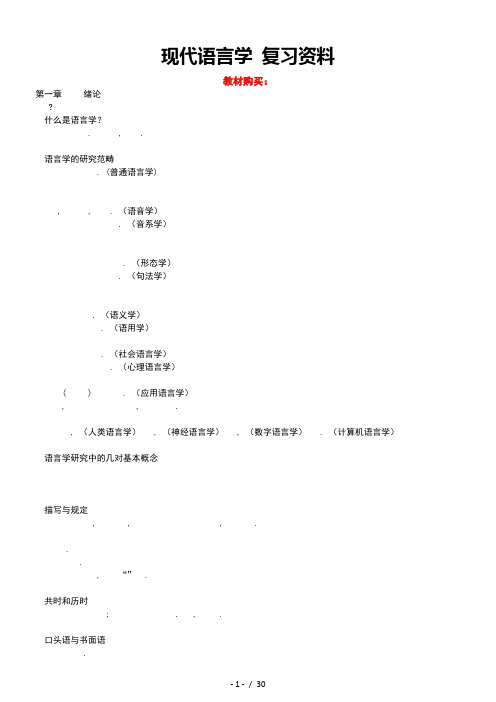
现代语言学复习资料教材购买:第一章绪论?. , .. (普通语言学), , . (语音学). (音系学). (形态学). (句法学). (语义学). (语用学). (社会语言学). (心理语言学)( ) . (应用语言学), , ., (人类语言学) , (神经语言学) , (数字语言学) . (计算机语言学), , , ..., “” .; . , ., .:. ;. ;. , , .[ə'ə]. ., .. , .语言能力和语言运用. ’.’ , . .?.“”“”“” ., , ., .甄别性特征..)., . ., . , . .), .), , , . , , . . ), , . . , .), , .**********************************音系学., . . “” ., .(语言的声音媒介) .(语音).. ?;’ .(发音语音学), ’ . .(听觉语音学),’ . .(声学语音学), . ..咽腔口腔鼻腔语音解剖图发音器官图–. (字母符号) , (宽式音标). (变音符号), (窄式音标). 音的比较[][]音的比较在元音前,叫清晰音,在宽式音标中不作标示,写作:[][][][],在窄式音标中加变音符号[])发音方式分塞音或爆破音: [] [] [] [] [] []擦音:[] [] [] [] [] [] [] [] []塞擦音:[][][] [][] [] [][] [])[] [] [] [][] [][] [][] [] [] [] [] [] [][][][][][] [] [][])前元音:[:] [] [] [] []中元音:[[:] [[] []后元音:[:] [] [:] [] [:])闭元音:[:] [] [:] []半闭元音:[] [[:]开元音:[] []半开元音:[[] [:] [] [] [:])不圆唇元音:[:] [] [] [] [] [[:] [[] [] [:] 圆唇元音:[:] [] [:] [])长元音[:] [[:][:] [:] [:]短元音[] [] [] [] [[] [] [] []音系学., ;, . ., ,. . .定能区分意义。
语言学简答题问答题答案
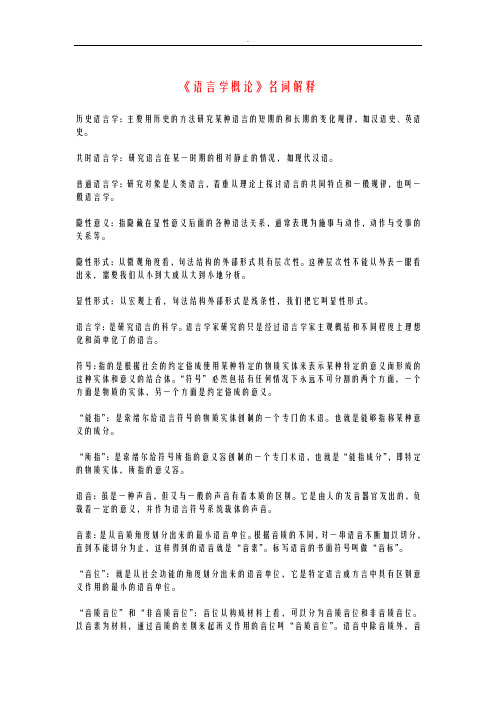
《语言学概论》名词解释历史语言学:主要用历史的方法研究某种语言的短期的和长期的变化规律,如汉语史、英语史。
共时语言学:研究语言在某一时期的相对静止的情况,如现代汉语。
普通语言学:研究对象是人类语言,着重从理论上探讨语言的共同特点和一般规律,也叫一般语言学。
隐性意义:指隐藏在显性意义后面的各种语法关系,通常表现为施事与动作,动作与受事的关系等。
隐性形式:从微观角度看,句法结构的外部形式具有层次性。
这种层次性不能从外表一眼看出来,需要我们从小到大或从大到小地分析。
显性形式:从宏观上看,句法结构外部形式是线条性,我们把它叫显性形式。
语言学:是研究语言的科学。
语言学家研究的只是经过语言学家主观概括和不同程度上理想化和简单化了的语言。
符号:指的是根据社会的约定俗成使用某种特定的物质实体来表示某种特定的意义而形成的这种实体和意义的结合体。
“符号”必然包括有任何情况下永远不可分割的两个方面,一个方面是物质的实体,另一个方面是约定俗成的意义。
“能指”:是索绪尔给语言符号的物质实体创制的一个专门的术语。
也就是能够指称某种意义的成分。
“所指”:是索绪尔给符号所指的意义容创制的一个专门术语,也就是“能指成分”,即特定的物质实体,所指的意义容。
语音:虽是一种声音,但又与一般的声音有着本质的区别。
它是由人的发音器官发出的,负载着一定的意义,并作为语言符号系统载体的声音。
音素:是从音质角度划分出来的最小语音单位。
根据音质的不同,对一串语音不断加以切分,直到不能切分为止,这样得到的语音就是“音素”。
标写语音的书面符号叫做“音标”。
“音位”:就是从社会功能的角度划分出来的语音单位,它是特定语言或方言中具有区别意义作用的最小的语音单位。
“音质音位”和“非音质音位”:音位从构成材料上看,可以分为音质音位和非音质音位。
以音素为材料,通过音质的差别来起辨义作用的音位叫“音质音位”。
语音中除音质外,音高、音强、音长也能起这种作用,因此也构成音位。
现代语言学前五章课后习题答案
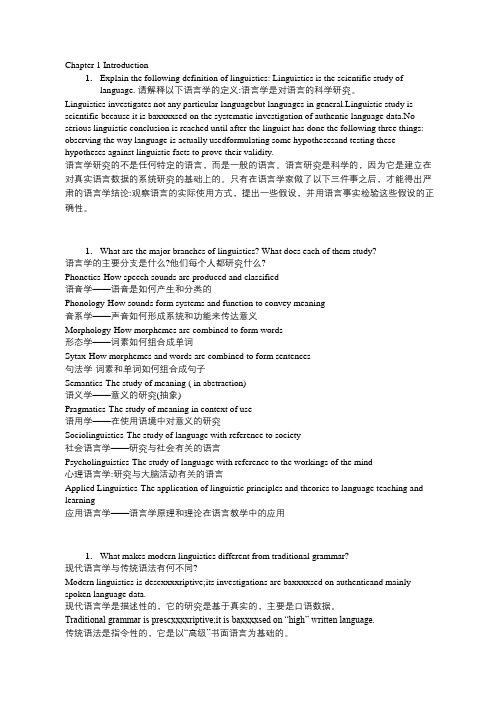
Chapter 1 Introduction1.Explain the following definition of linguistics: Linguistics is the scientific study oflanguage. 请解释以下语言学的定义:语言学是对语言的科学研究。
Linguistics investigates not any particular languagebut languages in general.Linguistic study is scientific because it is baxxxxsed on the systematic investigation of authentic language data.No serious linguistic conclusion is reached until after the linguist has done the following three things: observing the way language is actually usedformulating some hypothesesand testing these hypotheses against linguistic facts to prove their validity.语言学研究的不是任何特定的语言,而是一般的语言。
语言研究是科学的,因为它是建立在对真实语言数据的系统研究的基础上的。
只有在语言学家做了以下三件事之后,才能得出严肃的语言学结论:观察语言的实际使用方式,提出一些假设,并用语言事实检验这些假设的正确性。
1.What are the major branches of linguistics? What does each of them study?语言学的主要分支是什么?他们每个人都研究什么?Phonetics-How speech sounds are produced and classified语音学——语音是如何产生和分类的Phonology-How sounds form systems and function to convey meaning音系学——声音如何形成系统和功能来传达意义Morphology-How morphemes are combined to form words形态学——词素如何组合成单词Sytax-How morphemes and words are combined to form sentences句法学-词素和单词如何组合成句子Semantics-The study of meaning ( in abstraction)语义学——意义的研究(抽象)Pragmatics-The study of meaning in context of use语用学——在使用语境中对意义的研究Sociolinguistics-The study of language with reference to society社会语言学——研究与社会有关的语言Psycholinguistics-The study of language with reference to the workings of the mind心理语言学:研究与大脑活动有关的语言Applied Linguistics-The application of linguistic principles and theories to language teaching and learning应用语言学——语言学原理和理论在语言教学中的应用1.What makes modern linguistics different from traditional grammar?现代语言学与传统语法有何不同?Modern linguistics is descxxxxriptive;its investigations are baxxxxsed on authenticand mainly spoken language data.现代语言学是描述性的,它的研究是基于真实的,主要是口语数据。
现代语言学的特点

现代语言学的特点一、综合性现代语言学是一门综合性的学科,它综合了语言学的各个分支领域,如音韵学、形态学、句法学、语义学、语用学等,以及语言学与其他学科的交叉研究,如心理学、认知科学、社会学、人类学等。
现代语言学不再局限于研究单一的语言现象,而是以全球语言为研究对象,探索语言的普遍规律和多样性。
二、科学性现代语言学强调科学方法的运用,以数据为基础,采用实证研究的方式进行观察、实验和分析。
研究者通过收集和分析大量的语言数据,运用统计学和计算机技术等工具,来揭示语言的结构、功能和变化规律。
现代语言学倡导理论与实践相结合,追求科学性和实用性的统一。
三、描述性现代语言学强调对语言现象的客观描述,而非主观评价。
研究者通过描述语言的音韵、词汇、语法和语义等方面的特点,以及语言使用者的语言行为和语言交际情境,来揭示语言的内在规律和外部功能。
现代语言学关注语言的实际使用,强调对语言使用情境的分析和解释。
四、系统性现代语言学强调对语言的整体性和系统性的研究。
研究者关注语言的层次结构和相互关系,研究语言的规则和规律。
现代语言学通过研究语音、词汇、句法、语义等多个层面的语言要素,揭示它们之间的相互作用和内在联系。
现代语言学还关注语言变化和语言演化的过程,探讨语言系统的变动和发展。
五、认知性现代语言学强调语言与认知的密切关系。
研究者通过认知心理学和认知神经科学的方法,探索语言的认知机制和神经基础。
现代语言学关注语言的语言思维和语言表达,研究语言对思维的影响和反映。
现代语言学还研究语言的习得过程和语言障碍的机制,揭示语言与认知发展之间的关系。
六、应用性现代语言学强调语言研究的应用价值。
研究者将语言学的理论和方法应用于语言教学、语言治疗、机器翻译、语音识别等领域,为实际问题提供解决方案。
现代语言学还关注语言政策、语言规划和语言政治等社会实践问题,为促进语言多样性和语言平等做出贡献。
现代语言学以综合性、科学性、描述性、系统性、认知性和应用性为特点,旨在揭示语言的内在规律和外部功能,推动语言学的发展和应用。
自考《现代语言学》复习题及答案
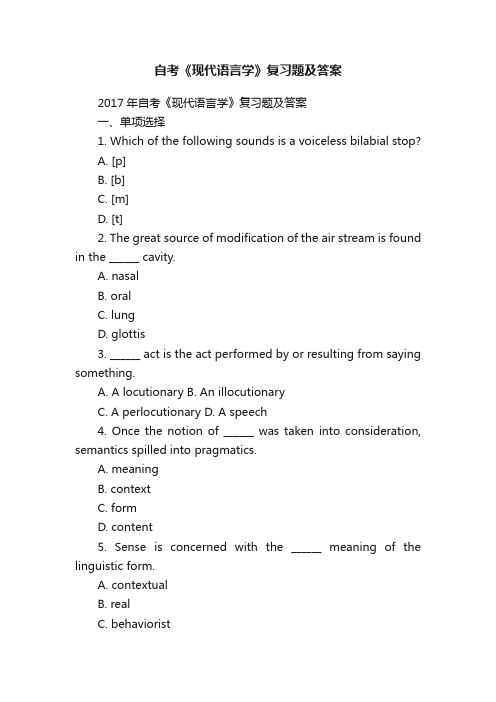
自考《现代语言学》复习题及答案2017年自考《现代语言学》复习题及答案一、单项选择1. Which of the following sounds is a voiceless bilabial stop?A. [p]B. [b]C. [m]D. [t]2. The great source of modification of the air stream is found in the ______ cavity.A. nasalB. oralC. lungD. glottis3. ______ act is the act performed by or resulting from saying something.A. A locutionaryB. An illocutionaryC. A perlocutionaryD. A speech4. Once the notion of ______ was taken into consideration, semantics spilled into pragmatics.A. meaningB. contextC. formD. content5. Sense is concerned with the ______ meaning of the linguistic form.A. contextualB. realC. behavioristD. inherent6. Hyponyms of the same ______ are co-hyponyms.A. wordB. lexical itemC. superordinateD. hyponym7. Words that are opposite in meaning are ______.A. synonymsB. hyponymsC. antonymsD. homophones8. The word “modernizers” is composed of _____ morphemes.A. 3B. 4C. 5D. 69. According to F. de Saussure, _____ refers to the abstract linguistic system shared by all the members of a speech community.A. paroleB. performanceC. langueD. language10. Language is arbitrary in that there is no logical connection between meanings and ______.A. wordsB. soundsC. objectsD. ideas11. ______ morphemes are those that cannot be used independently but have to be combined with other morphemes, either free or bound, to form a word.A. FreeB. BoundC. RootD. Affix12. The smallest meaningful unit of language is ______.A. rootB. affixC. stemD. morpheme13. _____ refers to a word or expression that is prohibited by the “polite” society from general use.A. Linguistic tabooB. EuphemismC. Address termD. Slang14. Lying under the skull, the human brain contains an average of the ten billion nerve cells called ______.A. neuronsB. nerve systemC. nervesD. cerebral cortex15. ______ language belongs to the Sino-Tibetan Family.A. EnglishB. SpanishC. IndianD. Chinese参考答案:1--- 5ABCBD 6---10CCBCB 11---15BDAAD二、名词解释 (每个2分,共20 分)1. Linguistics is generally defined as the scientific study of language.2. Morphology is a branch of grammar which studies the internal structure of words and the rules by which words are formed.3. Reference means what a linguistic form refers to in the real physical world; it deals with the relationship between the linguistic element and the non-linguistic world of experience.4. An illocutionary act is the act of expressing the speaker’s intention; it is the act performing is saying something.5. Speech community is thus defined as a group of people who form a community (which may have few members as a family or as many members as a country), and share the same language or a particular variety of language.6. Language is a system of arbitrary vocal symbols used for human communication.7. Inflectional affixes or inflectional morphemes manifest various grammatical relations or grammatical categories such as number, tense, degree, and case.8. Pragmatics is the study of how speakers of language use sentences to effect successful communication.9. Accent refers to a way of pronunciation which tells the listener something about the speaker’s regional or social background.10. A lingua franca is a variety of language that serves as a medium of communication among groups of people from diverse linguistic backgrounds.三、简答题(每小题5分,共20分)1. What is the distinction between competence andperformance?Competence and performance was proposed by the American linguist N. Chomsky in the la te 1950’s. Chomsky defines competence as the ideal user’s knowledge of the rules of his language, and performance the actual realization of this knowledge in linguistic communication.2. What are the sense relations between sentences?Sense relations between sentences:1) X is synonymous with Y.2) X is inconsistent with Y.3) X entails Y.(Y is an entailment of X.)4) X presupposes Y. (Y is a prerequisite of X)5) X is a contradiction.6) X is semantically anomalous.3. What is idiolect?When an individual speaks, what is actually produced is a unique language system of the speaker, expressed within the overall system of a particular language. Such a personal dialect is referred to as idiolect.4. What is the Sapir-Whorf hypothesis?Sapir-Whorf proposed first that all higher levels of thinking are dependent on language. Or put it more bluntly, language determines thought, hence the strong notion of linguistic determinism. Because languages differ in many ways, Whorf also believed that speakers of different languages perceive and experience the world differently, that is, relative to their linguistic background, hence the notion of linguistic relativism. In short, the strong version of the Sapir-Whorf hypothesis proposes that the language we speak determines the way we perceive the world and therefore the nature of thought.四、论述题(每小题10分,共30分)1. What are the design features of language?Design features refer to the defining properties of human language that distinguish it from any animal system of communication.1) arbitrariness2) productivity3) duality4) displacement5) cultural transmission2. Draw a labeled constituent structure tree diagram for each of the following sentences:1) The student likes the new linguistics professor.2) John suggested Mary take the linguistics class.1. The student likes the new linguistics professor.2. John suggested (that) Mary take the linguistics class.3. What is the difference between acquisition and learning? Illustrate with examples.Acquisition refers to the gradual and subconscious development of ability in the first language by using it naturally in daily communicative situations. Learning, however, is defined as a conscious process of accumulating knowledge of a second language usually obtained in school settings. It is recognized that children acquire their native language without explicit learning.A second language is more commonly learned but to some degree may also be acquired, depending on the environmental setting and the input received by the L2 learner.【2017年自考《现代语言学》复习题及答案】。
现代语言学教程 整理笔记.
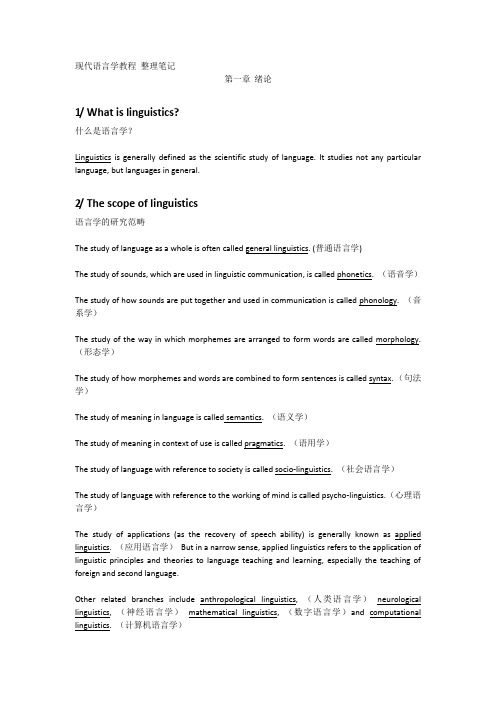
现代语言学教程整理笔记第一章绪论1/ What is linguistics?什么是语言学?Linguistics is generally defined as the scientific study of language. It studies not any particular language, but languages in general.2/ The scope of linguistics语言学的研究范畴The study of language as a whole is often called general linguistics. (普通语言学)The study of sounds, which are used in linguistic communication, is called phonetics. (语音学)The study of how sounds are put together and used in communication is called phonology. (音系学)The study of the way in which morphemes are arranged to form words are called morphology. (形态学)The study of how morphemes and words are combined to form sentences is called syntax. (句法学)The study of meaning in language is called semantics. (语义学)The study of meaning in context of use is called pragmatics. (语用学)The study of language with reference to society is called socio-linguistics. (社会语言学)The study of language with reference to the working of mind is called psycho-linguistics. (心理语言学)The study of applications (as the recovery of speech ability) is generally known as applied linguistics. (应用语言学)But in a narrow sense, applied linguistics refers to the application of linguistic principles and theories to language teaching and learning, especially the teaching of foreign and second language.Other related branches include anthropological linguistics, (人类语言学)neurological linguistics, (神经语言学)mathematical linguistics, (数字语言学)and computational linguistics. (计算机语言学)3/ Some important distinctions in linguistics语言学研究中的几对基本概念Prescriptive and descriptive 规定与描写If a linguistic study describes and analyzes the language people actually use, it is said to be descriptive, if it aims to lay down rules to tell people what they should say and what they should not say, it is said to be prescriptive.Modern linguistics differs from traditional grammar. Traditional grammar is prescriptive while modern linguistics is descriptive. The task of linguists is supposed to describe the language people actually use, whether it is “correct” or not.Synchronic and diachronic 共时和历时The description of a language at some point in time is a synchronic study; the description of a language as it changes through time is a diachronic study. In modern linguistics, synchronic study is more important.Speech and writing 口头语与书面语Speech and writing are the two major media of communication. Modern linguistics regards the spoken form of language as primary, but not the written form. Reasons are: 1. Speech precedes writing; 2. There are still many languages that have only the spoken form; 3. In terms of function, the spoken language is used for a wider range of purposes than the written, and carries a larger load of communication than the written.Langue and parole 语言和言语The Swiss linguist F. de Saussure made the distinction between langue and parole early 20th century.Langue refers to the abstract linguistic system shared by all the members of a speech community, and parole refers to the realization of langue in actual use. Saussure made the distinction in order to single out one aspect of language for serious study. He believes what linguists should do is to abstract langue from parole, to discover the regularities governing the actual use of language and make them the subjects of study of linguistics.Competence and performance 语言能力和语言运用Proposed by American linguist N. Chomsky in the late 1950’s.He defines competence as the ideal user’s knowledge of the rules of his language, and performance the actual realization of this knowledge in linguistic communication. He believes the task of the linguists is to discover and specify the language rules.4/ What is language?语言的定义Language is a system of arbitrary vocal symbols used for human communication.Sapir uses “ideas”“emotions” and “desires” in his definition. Hall, like Sapir, treats language as a purely human institution. Chomsky’s definition is quite different, it focus on the purely structural properties of languages and to suggest that these properties can be investigated from a mathematically precise point of view.5/ Design features语言的甄别性特征Design features refer to the defining properties of human language that distinguish it from any animal system of communication. American linguist Charles Hockett specified twelve design features, five of which will be discussed here.Arbitrariness 语言的随意性Arbitrariness means that there is no logical connection between meanings and sounds. It is not entirely arbitrary.Example: different sounds are used to refer to the same object in different languages. Productivity 语言的创造性Language is productive in that it makes possible the construction and interpretation of new signals by its users. This is why they can produce and understand an infinitely large number of sentences, including sentences they have never heard before.Duality 语言的二重性The duality nature of language means that language is a system, which consists of two sets of structure, or two levels, one of sounds and the other of meaning.Displacement 语言的移位性Displacement means that language can be used to refer to things which are present or not present, real or imagined matters in the past, present, or future, or in far-away places.Cultural transmission 语言的文化传递性While human capacity for language has a genetic basis, i.e., we were born with the ability to acquire language, the details of any language are not genetically transmitted, but instead have to be taught and learned anew. This indicates that language is culturally transmitted. It is passed down from one generation to the next through teaching and learning, rather than by instinct.Chapter 2 Phonology 音系学1.The phonic medium of language语言的声音媒介Speech and writing are the two media used by natural languages as vehicles for communication. Of the two media of language, speech is more basic than writing. Speech is prior to writing. The writing system of any language is always “invented” by its users to record speech when the need arises.For linguists, the study of sounds is of greater importance than that of writing.The limited ranges of sounds which are meaningful in human communication and are of interest to linguistic studies are the phonic medium of language (语言的声音媒介) . The individual sounds within this range are the speech sounds (语音). 2.What is phonetics?什么是语音学?Phonetics is defined as the study of the phonic medium of language;It is concerned with all the sounds that occur in the world’s languages.语音学研究的对象是语言的声音媒介,即人类语言中使用的全部语音。
现代汉语简答题[整理版]
![现代汉语简答题[整理版]](https://img.taocdn.com/s3/m/3df3981977c66137ee06eff9aef8941ea76e4b47.png)
1.北方话作为普通话的词汇基础有很多优势条件,请你任选一方面谈谈。
第一,北方话在我国政治、经济方面的影响大,北方话区域历来是我国政治经济中心区域;第二,北方话具有雄厚的文化基础,我们现在使用的书面语白话,就是在北方话基础上发展起来的,许多文学名著也是使用北方话写的,这些作品的流传,促进了北方话在全国的传播;第三,北方话具有广泛的群众基础,使用人口占整个汉民族的7 0 % ;第四,北方话通行地域广阔,从东北到西南,从西北到东南的南京,在这样大的范围内通话基本上没有问题。
(答对其中一个要点并适当展开即可给满分)2. 举例说明成语和惯用语在语音形式和结构关系方面有什么不同?第一,从语音看,成语以四个音节为主,惯用语以三个音节为主; 第二,从结构看,成语结构关系多种多样,惯用语以述宾关系和偏正关系为主。
3. "重要"和"主要"是不是同一词类?二者在功能上有哪些不同?"重要"和"主要"都是形容词,但"重要"属于普通形容词,"主要"属于非谓形容词。
二者在功能上的主要区别是:第一,"重要"可以受副词修饰,"主要"不能受副词修饰;第二,"重要"可以充当谓语,"主要"不能充当谓语。
4. 举例说明什么是简化字? 是不是笔画少的字就是简化字?简化字相对繁体字而言,是指改造原来笔画结构复杂的繁体字而形成的笔画结构简单的汉字。
例如"馬"繁体字,简化后的"马"就是简化字。
简化字有特定的内涵,不是笔画少的汉字就是简化字,例如"上、下、一"这些字不是简化字。
5. 网络语言要不要规范? 请谈谈你的看法。
这个问题学生可以肯定或否定回答,只要言之成理,同样给分。
肯定回答要点:网络语言需要规范。
当代语言学
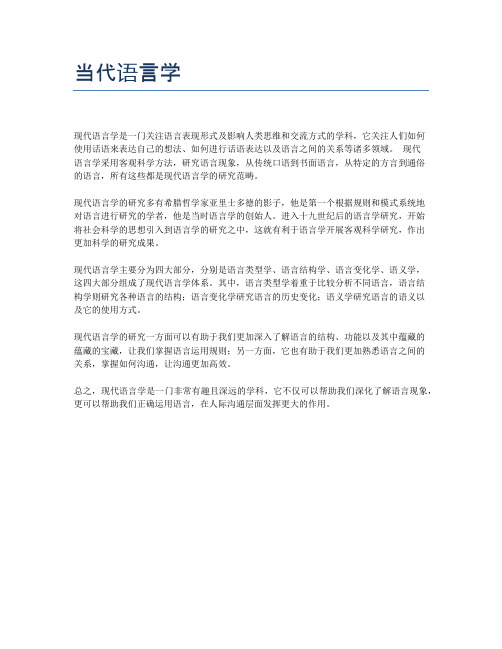
当代语言学
现代语言学是一门关注语言表现形式及影响人类思维和交流方式的学科,它关注人们如何
使用话语来表达自己的想法、如何进行话语表达以及语言之间的关系等诸多领域。
现代
语言学采用客观科学方法,研究语言现象,从传统口语到书面语言,从特定的方言到通俗
的语言,所有这些都是现代语言学的研究范畴。
现代语言学的研究多有希腊哲学家亚里士多德的影子,他是第一个根据规则和模式系统地
对语言进行研究的学者,他是当时语言学的创始人。
进入十九世纪后的语言学研究,开始
将社会科学的思想引入到语言学的研究之中,这就有利于语言学开展客观科学研究,作出
更加科学的研究成果。
现代语言学主要分为四大部分,分别是语言类型学、语言结构学、语言变化学、语义学,
这四大部分组成了现代语言学体系。
其中,语言类型学着重于比较分析不同语言,语言结
构学则研究各种语言的结构;语言变化学研究语言的历史变化;语义学研究语言的语义以
及它的使用方式。
现代语言学的研究一方面可以有助于我们更加深入了解语言的结构、功能以及其中蕴藏的
蕴藏的宝藏,让我们掌握语言运用规则;另一方面,它也有助于我们更加熟悉语言之间的
关系,掌握如何沟通,让沟通更加高效。
总之,现代语言学是一门非常有趣且深远的学科,它不仅可以帮助我们深化了解语言现象,更可以帮助我们正确运用语言,在人际沟通层面发挥更大的作用。
历年自考现代语言学简答题目
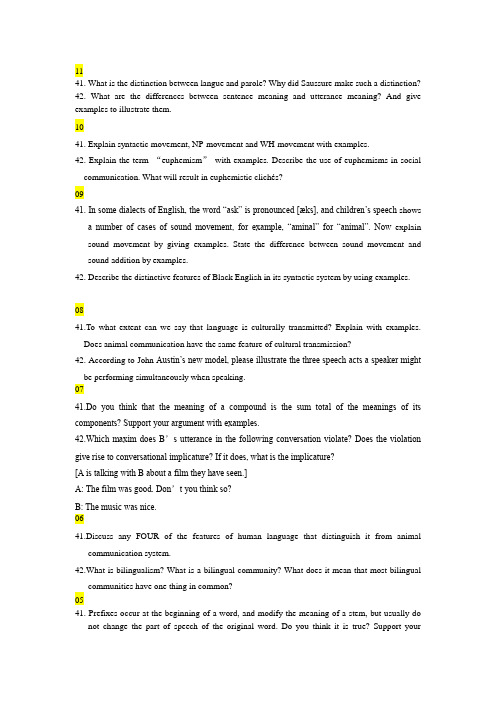
1141. What is the distinction between langue and parole? Why did Saussure make such a distinction?42. What are the differences between sentence meaning and utterance meaning? And give examples to illustrate them.1041. Explain syntactic movement, NP-movement and WH-movement with examples.42. Explain the term “euphemism”with examples. Describe the use of euphemisms in social communication. What will result in euphemistic clichés?0941. In some dialects of English, the word “ask” is pronounced [æks], and children’s speech showsa number of cases of sound movement, for example, “aminal” for “animal”. Now explainsound movement by giving examples. State the difference between sound movement and sound addition by examples.42. Describe the distinctive features of Black English in its syntactic system by using examples.0841.To what extent can we say that language is culturally transmitted? Explain with examples. Does animal communication have the same feature of cultural transmission?42. According to John Austin’s new model, please illustrate the three speech acts a speaker might be performing simultaneously when speaking.0741.Do you think that the meaning of a compound is the sum total of the meanings of its components? Support your argument with examples.42.Which maxim does B’s utterance in the following conversation violate? Does the violation give rise to conversational implicature? If it does, what is the implicature?[A is talking with B about a film they have seen.]A: The film was good. Don’t you think so?B: The music was nice.0641.Discuss any FOUR of the features of human language that distinguish it from animalcommunication system.42.What is bilingualism? What is a bilingual community? What does it mean that most bilingualcommunities have one thing in common?0541. Prefixes occur at the beginning of a word, and modify the meaning of a stem, but usually donot change the part of speech of the original word. Do you think it is true? Support youranswer with examples.42. What are the four maxims of the Cooperative Principle? Please give examples to show howthe flouting of these maxims gives rise to conversational implicature (Give at least two examples, each flouting a different maxim).05 0141. Under what conditions will two sounds be assigned to the same phoneme?42. For the following sentence, draw a tree diagram to reveal its underlying structure.The girl ate the orange.43. Study the passage taken from Shakespeare’s HAMLET below carefully and identify every difference in expression between Elizabethan and Modern English that is evident.King: Where is Polonius?Hamlet: In heaven, Send thither to see.If your messenger find him not there,seek him i’the other place yourself.But indeed, if you find him not withinthis month, you shall nose him as yougo up the stairs into the lobby.0441. The phonological features that occur above the level of individual sounds are calledsuprasegmental features. Discuss the main suprasegmental features, illustrating with examples how they function in the distinction of meaning.42. Explain and give examples to show in what way componential analysis is similar to the analysis of phonemes into distinctive features.0341. Explain sociological triggers for language change by giving a typical example in the history of English.42. Explain briefly the four main individual learner factors that affect a learner’s acquisition of a second language.0241.Explain with examples the three notions of phone, phoneme and allophone, and also how they are related.42.Explain what is sense and what is reference with examples.0141.In addition to revealing a linear order, a constituent structure tree has a hierarchical structure that groups words into structural constituents and shows the syntactic category of each structural constituent, and consequently is believed tomost truthfully illustrate the constituent relationship among linguistic elements.For example, the phrase " the old men and women" may have two interpretations,i.e.the adjective "old”may modify the noun "men", or the following two nouns "men andwomen".Linear order analysis cannot tell this difference, so it is ambiguous.Whereas,theconstituent or tree diagrams analysis can make this difference clear.So,we say tree diagrams are more advantageous and informative than linear structure analysis.NP NPNP NP NP NPThe old men and the women the old men and the old women42.From the perspective of psycholinguistic analysis,language use in terms ofperception,comprehension and production follows a certain pattern which involves the coordination of various language centers.When we speak,words are drawn from Wernicke's area and transferred to Broca's area, which determines the details of their form and pronunciation.The appropriate instructions are then sent to the motor area which controls the vocal tract to physically articulate the words.When we hear something and try to comprehend it,t he stimulus from the auditory cortex is transmitted to Wernicke's area,where it is then interpreted.When we perceive a visual image,a message is sent to the angular gyrus,where it is converted into a visual pattern.。
现代语言学笔记及课后答案
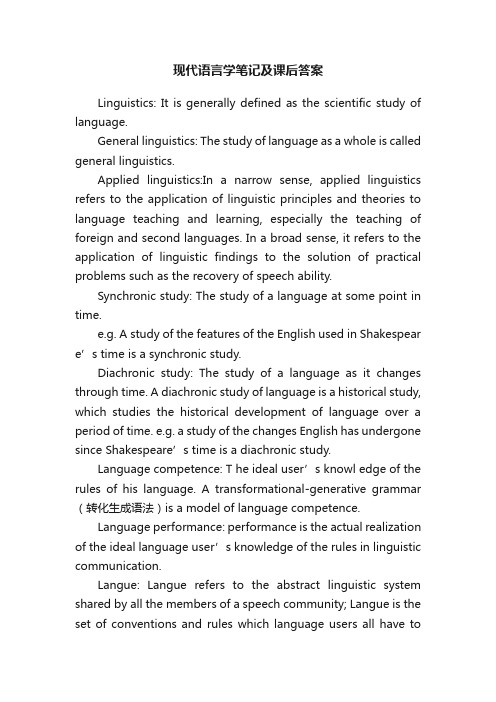
现代语言学笔记及课后答案Linguistics: It is generally defined as the scientific study of language.General linguistics: The study of language as a whole is called general linguistics.Applied linguistics:In a narrow sense, applied linguistics refers to the application of linguistic principles and theories to language teaching and learning, especially the teaching of foreign and second languages. In a broad sense, it refers to the application of linguistic findings to the solution of practical problems such as the recovery of speech ability.Synchronic study: The study of a language at some point in time.e.g. A study of the features of the English used in Shakespear e’s time is a synchronic stud y.Diachronic study: The study of a language as it changes through time. A diachronic study of language is a historical study, which studies the historical development of language over a period of time. e.g. a study of the changes English has undergone sin ce Shakespeare’s time is a diachronic study.Language competence: T he ideal user’s knowl edge of the rules of his language. A transformational-generative grammar (转化生成语法)is a model of language competence.Language performance: performance is the actual realization of the ideal language user’s knowledge of the rules in linguistic communication.Langue: Langue refers to the abstract linguistic system shared by all the members of a speech community; Langue is the set of conventions and rules which language users all have tofollow; Langue is relatively stable, it does not change frequently. Parole:Parole refers to the realization of langue in actual use; parole is the concrete use of the conventions and the application of the rules; parole varies from person to person, and from situation to situation.Language: Language is a system of arbitrary vocal symbols used for human communication.Arbitrariness: It is one of the design features of language. It means that there is no logical connection between meanings and sounds. A good example is the fact that different sounds are used to refer to the same object in different languages.Productivity: Language is productive or creative in that it makes possible the construction and interpretation of new signals by its users.Duality: Language is a system, which consists of two sets of structure, or two levels, one of sounds at the lower or basic level, and the other of meanings at the higher level.Displacement: language can be used to refer to things which are present or not present, real or imagined matters in the past, present, or future, or in far-away places. In other words, language can be used to refer to contexts removed from the immediate situations of the speaker.Cultural transmission: While we are born with the ability to acquire language, the details of any language are not genetically transmitted, but instead have to be taught and learned.Design features: It refers to the defining properties of human language that distinguish it from any animal system of communicationphonetics: Phonetics is defined as the study of the phonic medium of language; it is concerned with all the sounds thatoccur in the world’ s languagesauditory phonetics: It studies the speech sounds from the hearer’s point of view. It studies how the sounds are perceived by the hearer.acoustic phonetics: It studies the speech sounds by looking at the sound waves. It studies the physical means by which speech sounds are transmitted through the air from one person to another. international phonetic alphabet [IPA]: It is a standardized and internationally accepted system of phonetic transcription.Broad transcription:the transcription with letter-symbols only, i.e. one letter-symbol for one sound. This is the transcription normally used in dictionaries and teaching textbooks.Narrow transcription: is the transcription with letter-symbols together with the diacritics. This is the transcription used by the phoneticians in their study of speech sounds.diacritics: is a set of symbols which can be added to the letter-symbols to make finer distinctions than the letters alone make possible.Voiceless(清音): when the vocal cords are drawn wide apart, letting air go through without causing vibration, the sounds produced in such a condition are called voiceless sounds.Voicing (浊音): Sounds produced while the vocal cords are vibrating are called voiced sounds.Vowel: the sounds in production of which no articulators come very close together and the air stream passes through the vocal tract without obstruction are called vowels.Consonants: the sounds in the production of which there is an obstruction of the air stream at some point of the vocal tract are called consonants.phonology: Phonology studies the system of sounds of a particular language; it aims to discover how speech sounds in a language form patterns and how these sounds are used to convey meaning in linguistic communication.phone: Phones can be simply defined as the speech sounds we use when speaking a language. A phone is a phonetic unit or segment. It does not necessarily distinguish meaning.phoneme:a collection of abstract phonetic features, it is a basic unit in phonology. It is represented or realized as a certain phone by a certain phonetic context.allophone: The different phones which can represent a phoneme in different phonetic environments are called the allophones of that phoneme. For example [l] and [l]phonemic contrast:Phonemic contrast refers to the relation between two phonemes. If two phonemes can occur in the same environment and distinguish meaning, they are in phonemic contrast.Complementary distribution:refers to the relation between two similar phones which are allophones of the same phoneme, and they occur in different environments.minimal pair:When two different forms are identical in every way except for one sound segment which occurs in the same place in the strings, the two words are said to form a minimal pair. For example: bin and pin.suprasegmental features: the phonemic features that occur above the level of the segments are called suprasegmental features. The main suprasegmental features include stress, tone and intonation.tone: Tones are pitch variations, which are caused by the differing rates of vibration of the vocal cords. Pitch variation candistinguish meaning just like phonemes. The meaning-distinctive function of the tone is especially important in tone languages, for example, in Chinese.intonation: When pitch, stress and sound length are tied to the sentence rather than the word in isolation, they are collectively known as intonation. For example, English has four basic types of intonation: the falling tone, the rising tone, the fall-rise tone and the rise-fall tone.Morphology: Morphology is a branch of grammar which studies the internal structure of words and the rules by which words are formed. It is divided into two sub-branches: inflectional morphology and lexical or derivational morphology.Inflectional morphology: The inflectional morphology studies the inflectionsDerivational morphology: Derivational morphology is the study of word-formation.Morpheme: It is the smallest meaningful unit of language. For example: the word “boyish” consists of two morphemes: “boy” and “ish”.Free morpheme: Free morphemes are the morphemes which are independent units of meaning and can be used freely all by themselves or in combination with other morphemes. For example: “help”, “table”, “room” are all free morphemes.Bound morpheme: Bound morphemes are the morphemes which cannot be used independently but have to be combined with other morphemes, either free or bound, to form a word. For example: “-er”, “dis-“, “-less” are all bound morphemes.Root: A root is often seen as part of a word; it can never stand by itself although it bears clear, definite meaning; it must be combined with another root or an affix to form a word. Forexample: the root “geo-“combines with another root “-ology”, we get the word “geology”.Affix: morphemes manifesting various grammatical relations or grammatical categories such as number, tense, degree and case. Affixes are of two types: inflectional and derivational. Inflectional affixes manifest various grammatical relations or grammatical categories, such as “-ing”, “-est”, while derivational affixes are added to an existing form to create a word, such as “-ly”, “dis-“, “un-“.Inflection(屈折):the manifestation of various grammatical relationships through the addition of inflectional affixes, such as number, tense, degree and case.Prefix: Prefixes occur at the beginning of a word. Prefixes modify the meaning of the stem, but they usually do not change the part of speech of the original word.Suffix: Suffixes are added to the end of the stems; they modify the meaning of the original word and in many cases change its part of speech.Stem: A stem is the existing form to which a derivational affix can be added. A stem can be a bound root, a free morpheme, or a derived form himself.Derivation: Derivation is a process of word formation by which derivative affixes are added to an existing form to create a word.Compounding: Compounding can be viewed as the combination of two or sometimes more than two words to create new words.1). syntax: Syntax is a subfield of linguistics which studies thesentence structure of language. It consists of a set of abstract rules that allow words to be combined with other words toform grammatical sentences.2). linguistic competence: Universally found in the grammars ofall human languages, syntactic rules comprise the system of internalized linguistic knowledge of a language speakerknown as linguistic competence.3). sentence: A sentence is a structurally independent unit thatusually comprises a number of words to form a completestatement, question or command. Normally, a sentenceconsists of at least a subject and a predicate which containsa finite verb or a verb phrase.4). finite clause(定式子句): a clause that takes a subject and afinite verb, and at the same time stands structurally alone. (A simple sentence satisfies the structural requirements of afinite clause.)5). simple sentence: a simple sentence consists of a singleclause which contains a subject and a predicate and stands alone as its own sentence.6). coordinate sentence(并列句): A coordinate sentencecontains two clauses joined by a linking word called coordinating conjunction, such as “and”, “but”,“or”.7). complex sentence(复合句): a complex sentence containstwo or more clauses, one of which is incorporated (合成一体的)into the other. That is, the two clauses hold unequalstatus, one subordinating the other. The incorporated, orsubordinate, clause is normally called an embedded clause, and the clause into which it is embedded is called a matrix clause.8). hierarchical structure(层次结构): the sentence structure thatgroups words into structural constituents and shows thesyntactic category of each structural constituent, such as NP and VP.9). syntactic category: Apart from sentences and clauses, asyntactic category usually refers to a word (called a lexical category) or a phrase (called a phrasal category) that performs a particular grammatical function, such as thesubject or object in a sentence. Constituents that can be substituted for one another without loss of grammaticality belong to the same syntactic category.10). grammatical relations: The structural and logical functionalrelations of constituents are called grammatical relations. Thegrammatical relations of a sentence concern the way each noun phrase in the sentence relates to the verb. In manycases, grammatical relations in fact refer to who does what towhom.11). phrase structure rules: a rewrite rule that allows for thepossible combinations of words to form phrases andsentences.12). X-bar theory is a general and highly abstract schema thatcollapses all phrasal structure rules into a single format: X″→ (Spec) X (Compl). (In this format, Spec stands for specifierwhile Compl stands for complement. This theory is capable ofreducing the redundancies of individual phrasal structurerules and may well capture certain basic properties shared by all phrasal categories, i.e. NP, VP, AP, PP, across thelanguages of the world. )13). transformational rules: Transformational rules are the rulesthat transform one sentence type into another type.14). D-structure: D- structure is the level of syntacticrepresentation that exists before movement takes place.Phrase structure rules, with the insertion of the lexicon,generate sentences at the level of D-structure.(Phrase structure rules + the lexicon→D-structure →Movement rules →S-structure)15). S-structure: a level of syntactic representation after theoperation of necessary syntactic movement16). Move a: a general movement rule accounting for thesyntactic behavior of any constituent movement.17). Universal Grammar: a system of linguistic knowledge whichconsists of some general principles and parameters about natural languages.1). Semantics: Semantics can be simply defined as the study ofmeaning in language.2). Sense: Sense is concerned with the inherent meaning of thelinguistic form. It is the collection of all the features of the linguistic form; it is abstract and de-contextualized.3). Reference: Reference means what a linguistic form refers to inthe real, physical world; it deals with the relationship between the linguistic element and the non-linguistic world of experience.4). Synonymy: Synonymy refers to the sameness or closesimilarity of meaning. Words that are close in meaning are called synonyms.5). Polysemy: Polysemy refers to the fact that the same one wordmay have more than one meaning.6). Homonymy(同音异义,同形异义): Homonymy refers to thephenomenon that words having different meanings have the same form, i.e. , different words are identical in sound or spelling, or in both.7). Homophones(同音异义): When two words are identical insound, they are called homophones. e.g. rain/reign.8). Homographs同形异义: When two words are identical inspelling, they are homographs. e.g. tear v. / tear n.9). Complete homonyms: When two words are identical in bothsound and spelling, they are called complete homonyms. e.g.fast v. / fast adj.; scale v. /scale. n.10). Hyponymy(下义关系): Hyponymy refers to the sense relationbetween a more general, more inclusive word and a more specific word. The word which is more general is called a superordinate(上坐标词), and the more specific words arecalled its hyponyms. (Hyponyms of the same superordinate are co-hyponyms to each other.) e.g. superordinate: animal, hyponyms: dog, cat, lion, tiger.11). Antonymy: Antonymy refers to the relation of oppositeness ofmeaning (on different dimensions).12). Componential analysis(成分分析法): Componential analysisis a way proposed by structural semanticists to analyze word meaning. This approach is based on the belief that the meaning of a word can be divided into meaning components, which are called semantic features. For example: the word “man”is analyzed as comprising the features of +HUMAN, +ADULT, +ANIMATE, +MALE.13). Predication analysis(述谓结构分析): It is an approachproposed by British linguist G. Leech for sentential meaning analysis. In semantic analysis of a sentence, predication is the basic unit which is the abstraction of the meaning of a sentence. This applies to all forms of sentence, including statements, imperative and interrogative forms. A predication consists of argument(s) and predicate. An argument is a logical participant in a prediction, largely identical with the nominal element(s) in a sentence. A predicate is something said about an argument or it states the logical relation linking the arguments in a sentence.14). The grammatical meaning: The grammatical meaning of asentence refers to its grammaticality, i.e., its grammatical well-formedness. The grammaticality of a sentence is governed by the grammatical rules of the language.15). Two-place predication: A two-place predication is onewhichcontains two arguments.1). Pragmatics: the study of how speakers of a language usesentences to effect successful communication.2). Context: The notion of context is essential to the pragmaticstudy of language. It consists of (It is generally considered as constituted by) the knowledge that is shared by the speaker and the hearer. The shared knowledge is of two types: the knowledge of the language they use, and the knowledge about the world, including the general knowledge about the world and the specific knowledge about the situation in which linguistic communication is taking place.3). Utterance meaning: the meaning of an utterance is concrete,and context-dependent. Utterance is based on sentence meaning; it is realization of the abstract meaning of a sentence in a real situation of communication, or simply in a context. 4). Sentence meaning: The meaning of a sentence is often considered as the abstract, intrinsic property of the sentence itself in terms of a predication.5). Constative: Constatives were statements that either state ordescribe, and were verifiable;6). Performative: performatives, on the other hand, weresentences that did not state a fact or describe a state, and were not verifiable. Their function is to perform a particular speech act.7). Locutionary act: A locutionary act is the act of uttering words,phrases, clauses. It is the act of conveying literal meaning by means of syntax, lexicon and phonology.8). Illocutionary act: An illocutionary act is the act of expressingthe speaker’s intention; it is the act performed in saying something.9). Perlocutionary act: A perlocutionary act is the act performed byor resulting from saying something; it is the consequence of, or the change brought about by the utterance; it is the act performed by saying something.10). Cooperative Principle: It is a principle advanced by Paul Grice.His idea is that in making conversations, the participants must first of all be willing to cooperate, otherwise it would not be possible for them to carry on the talk. The content is: Make your conversational contribution such as required at the stage at which it occurs by the accepted purpose or direction of the talk exchange in which you are engaged.11). Conversational implicature: Most of the violations of thecooperative principles give rise to what Paul Grice calls “conversational implicatures.”When we violate any of these maxims, our language becomes indirect and implies an extra meaning.1) historical linguistics: a subfield of linguistics that studieslanguage change (or historical development of language).2) diachronic linguistics: a term used instead of historicallinguistics to refer to the study of language change at various points in time and at various historical stages.3) Old English: a major period in the history of Englishdevelopment that began in 449 and ended in 1100.4) Middle English: a major period in the history of Englishdevelopment that began with the arrival of the Norman French invaders in England in 1100 and ended in 1500.5) Modern English: a period in the history of English developmentthat began roughly from 1500 to the present.6) the Great Vowel Shift: a series of systematic sound change inthe history of English that involved seven long vowels and consequently led to one of the major discrepancies(差异)between English pronunciation and its spelling system.7) apocope: the deletion of a word-final vowel segment.8) epenthesis: the insertion of the consonant or vowel sound tothe middle of a word.9) Metathesis: Sound change as a result of sound movement isknown as metathesis. It involves a reversal in position of two neighbouring sound segments.10) Compounding: It is a process of combining two or more thantwo words into one lexical unit. For example: sailboat, big-mouth, three-year-old.11) Derivation: It is a process by which new words are formed bythe addition of affixes to the roots, stems or words. For example: uglification(丑化),finalize.12) Acronym: An acronym is a word created by combining theinitials of a number of words. For example: UNESCO(United Nations Educational, Scientific and Cultural Organization国际教科文组织),CD-ROM (compact disk of read-only-memory)13) blending: a process of forming a new word by combining partsof two words. For example: smog (smoke + fog), brunch (breakfast + lunch)14) abbreviation: an abbreviation is a shortened form of a word orphrase which represents the complete form. For example: TV (television), Dr (doctor), hr (hour), Jan (January)15) clipping: clipping is a kind of abbreviation of otherwise longerwords or phrases. For example: gym (gymnasium), zoo (zoological garden), fridge (refrigerator), e-mail (electronic mail), hi-fi (high fidelity).16) Back-formation: It is a process by which new words are formedby taking away the supposed suffix of an existing word. For example: typewrite (typewriter), edit (editor)17) semantic broadening: the process in which the meaning of aword becomes more general or inclusive than its historically earlier meaning.18) Semantic narrowing: Semantic narrowing is a process in whichthe meaning of a word becomes less general or inclusive than its historically earlier meaning.19) Semantic shift: Semantic shift is a process of semantic changein which a word loses its former meaning and acquires a new, sometimes related, meaning.20) protolanguage: the original (or ancestral) form of a languagefamily which has ceased to exist.21) language family: a group of historically (or genetically) relatedlanguages that have developed from a common ancestral language.22) Great Vowel Shift: It is a series of systematic sound change atthe end of the Middle English period approximately between 1400 and 1600 in the history of English that involved seven long vowels and consequently led to one of the major discrepancies between English pronunciation and its spelling system.23) Sound assimilation: Sound assimilation refers to thephysiological effect of one sound on another. In an assimilative process, successive sounds are made identical, or more similar, to one another in terms of place or manner of articulation, or of haplology.24) Haplology: It refers to the phenomenon of the loss of one oftwo phonetically similar syllables in sequence.25) cognate: a word in one language which is similar in form andmeaning to a word in another language because both languages have descended from a common source.26) internal borrowing: the application of a rule from one part of thegrammar to another part of the grammar by analogy(类推,类似)to its earlier operation.27) Grimm’s Law:Because these sound changes were sostrikingly regular and law-like, they became known as Grimm’s Law. According to this law, the Germanic languages were subject to a rule that changed all voiceless stops into fricatives after they split off from other Indo-European languages.1) sociolinguistics: the subdiscipline of linguistics that studieslanguage variation and language use in social context.2) speech community: a group of people who form acommunity and share at least one speech variety as well as similar linguistic norms.3) speech variety: Speech variety, also known as languagevariety, refers to any distinguishable form of speech used bya speaker or group of speakers. The distinctivecharacteristics of a speech variety may be lexical,phonological, morphological, syntactic, or a combinationof linguistic features.4) language planning: language standardization is known aslanguage planning. This means that certain authorities, such as the government or government agency of a country,choose a particular speech variety and spread the use of it, including its pronunciation and spelling systems, acrossregional boundaries.5) sociolect: a variety of language used by people belonging toa particular social class.6) idiolect: An idiolect is a personal dialect of an individualspeaker that combines aspects of all the elements regarding regional, social, and stylistic variation, in one form or another (以这样或那样的方式综合了有关地域、社会和文体变异的所有成份). In a narrower sense, what makes up one’s idiolect includes also such factors as voice quality音质, pitch音高and speech rhythm言语节奏, which all contribute to theidentifying features in an individual’ s speech.7) register: a functional speech or language variety thatinvolves degrees of formality depending on the speechsituation concerned.8) standard language: a superposed(迭生的,重合的)prestigious variety of language of a community or nation,usually based on the speech and writing of educated native speakers of the language. (P170)9) nonstandard language: Language varieties other than thestandard are called nonstandard languages10) lingua franca: a variety of language that serves as a commonspeech for social contact among groups of people whospeak different native languages or dialects.11) pidgin: a marginal contact language with a limited vocabularyand reduced grammatical structures, used by nativespeakers of other languages as a means of businesscommunication.12) creole: A creole language is originally a pidgin that hasbecome established as a native language in some speechcommunity. When a pidgin comes to be adopted by apopulation as its primary language, and children learn it as their first language, then the pidgin language is called a creole.13) diglossia: a sociolinguistic situation in which two verydifferent varieties of language co-exist in a speech community, each serving a particular social function and used fora particular situation14) bilingualism: ilingualism refers to a linguistic situation inwhich two standard languages are used either by an individual or by a group of speakers, such as the inhabitants of a particular region or a nation.15) ethnic dialect: Within a society, speech variation may comeabout because of different ethnic backgrounds. An ethnic language variety is a social dialect of a language, often cutting across regional differences. An ethnic dialect is spoken mainly by a less privileged population that has experienced some form of social isolation, such as racial discrimination or segregation.16) slang: Slang is a casual use of language that consists ofexpressive but non-standard vocabulary, typically of arbitrary, flashy浮华的and often ephemeral短暂的coinages创新词and figures of speech characterized by spontaneity自发性and sometimes by raciness活泼,充满活力.17) linguistic taboo: an obscene猥亵的, profane,亵渎的orswear word or expression that is prohibited from general use by the educated and “polite” society.18) euphemism: a word or expression that is thought to be mild,indirect, or less offensive and used as a polite substitute for the supposedly harsh and unpleasant word or expression. 19) Domain使用域: Domain refers to the phenomenon that most bilingual communities have one thing in common, that is, fairly clear functional differentiation of the two languages in respect of speech situations. For example: the Home Domain, Employment Domain etc.1) psycholinguistics: the study of language in relation to themind, with focus on the processes of language production生成, comprehension理解and acquisition掌握.2) cerebral cortex: the outside surface of the brain, it is thedecision-making organ of the body, which receives messages from all the sensory organs and where human cognitive abilities reside.3) brain lateralization: the localization of cognitive andperceptual functions in a particular hemisphere of the brain.4) linguistic lateralization: hemispheric specialization ordominance for language.5) dichotic listening: a research technique which has been usedto study how the brain controls hearing and language. The subjects wear earphones and simultaneously receive different sounds in the right and left ear, and are then asked to repeat what they hear.6) Broca’s area : It refers to the frontal lobe in the lef t cerebralhemisphere, which is vital to language. This area is discovered by Paul Broca, a French surgeon and anatomist.7) angular gyrus: The angular gyrus lies be hind Wernicke’ sarea. The angular gyrus is the language center responsible for converting a visual stimulus into an auditory form and vice versa. This area is crucial for the matching of a spoken form with a perceived object, for the naming of objects, and for the comprehension of written language , all of which require connections between visual and speech regions. 8) cerebral plasticity: According to Lenneberg, prior to the endof the critical period, both hemispheres are involved to some。
- 1、下载文档前请自行甄别文档内容的完整性,平台不提供额外的编辑、内容补充、找答案等附加服务。
- 2、"仅部分预览"的文档,不可在线预览部分如存在完整性等问题,可反馈申请退款(可完整预览的文档不适用该条件!)。
- 3、如文档侵犯您的权益,请联系客服反馈,我们会尽快为您处理(人工客服工作时间:9:00-18:30)。
3.What are the branches of linguistics? What does each of them study? (语言学的主要分支是什么。
每个分支的研究对象是什么?)Linguistics mainly involves the following branches:1)General linguistics, which is the study of language as a whole and which deals with the basic concepts, theories, descriptions, models and methods applicable in any linguistic study2)Phonetics, which studies the sounds that are used in linguistic communication3)Phonology, which studies how sounds are put together and used to convey meaning in communication4)Morphology, which studies the way in which morphemes are arranged to form words5)Syntax, which studies how morphemes and words are combined to form sentences6)Semantics, which is the study of meaning in language.7)Pragmatics, which is the study of meaning not in isolation, but in the context of use8)Sociolinguistics, which is the study of language with reference to society9)Psycholinguistics, which is the study of language with reference to the workings of mind.10)Applied linguistics, which is concerned about the application of linguistic findings in linguistic studies; in a narrow sense, applied linguistics refers to the application of linguistic principles and theories to language teaching, especially the teaching of foreign and second languages.11)Other related branches are anthropological linguistics(人类语言学), neurological linguistics(神经语言学), mathematical linguistics (数学语言学), and computational linguistics(计算机语言学).4.What makes modern linguistics different from traditional grammar? (现代语言学与传统语法有什么区别?)Traditional grammar is prescriptive(规定性); it is based on "high "(religious, literary) written language. It sets models for language users to follow. But Modern linguistics is descriptive(描述性); its investigations are based on authentic and mainly spoken language data. It is supposed to be scientific and objective and the task of linguists is supposed to describe the language people actually use, whether it is "correct" or not.5.Is modern linguistics mainly synchronic(共时性)or diachronic(历时性)? Why?(The description of language at some point in time is a synchronic study; the description of a language as it changes through time is a diachronic study.)Modern linguistics is mainly synchronic, focusing on the present-day language. Unless the various states of a language are successfully studied, it will not be possible to describe language from a diachronic point of view.6.Which enjoys priority in modern linguistics, speech or writing? Why?在现代语言学里说话或写作哪一个有优先权?为什么呢?Modern linguistics gives priority to the spoken language for the following reasons:First, speech precedes writing. The writing system is always a later invention used to record the speech. There are still some languages that only have the spoken form.Then, a larger amount of communication is carried out in speech than in writing.Third, speech is the form in which infants acquire their native language.7.Saussure 是如何区分语言langue和言语parole的?(The distinction between langue and parole was made by the famous Swiss linguist Ferdinand de Saussure early this century. Langue and parole are French words.)Langue refers to the abstract linguistic system shared by all the members of a speech community, and parole refers to the realization of langue in actual use. Langue is the set of conventions and rules which language users all have to follow while parole is the concrete use of the conventions and the application of the rules. Langue is abstract; it is not the language people actually use, but parole is concrete; it refers to the naturally occurring language events. Langue is relatively stable, it does not change frequently; while parole varies from person to person, and from situation to situation.8.Chomsky的语言能力competence和语言使用performance各指什么?(American linguist N. Chomsky in the late 1950’s proposed the distinction between competence and performance.)Chomsky defines competence as the ideal user’s knowledge of the rules of his language. This internalized set of rules enables the language user to produce and understand an infinitely large number of sentences and recognize sentences that are ungrammatical and ambiguous. According to Chomsky, performance is the actual realization of this knowledge in linguistic communication. Although the speaker’s knowledge of his mother tongue is perfect, his performances may have mistakes because of social and psychological factors such as stress, embarrassment, etc… Chomsky believes that what linguists should study is the competence, which is systematic, not the performance, which is too haphazard (偶然的).9.How is Saussure’s distinction between langue and parole similar to Chomsky’s distinction between competence and performance? And what is their difference?索绪尔是如何区分语言和言语类似乔姆斯基的区分能力和表现?和它们的区别是什么?Both Saussure and Chomsky make the distinction between the abstract language system and the actual use of language. Their purpose is to single out one aspect of language for serious study. They differ in that Saussure takes a sociological view of language and his notion of langue is a matter of social conventions, and Chomsky looks at language from a psychological point of view and to him competence is a property of the mind of each individual. 10.What characteristics of language do you think should be included in a good, comprehensive definition of language?你认为应该怎样用一个良好的,全面的定义来总结语言的特征?Language is a system of arbitrary vocal symbols used for human communication.First of all, language is a system, i.e. elements of language are combined according to rules.Second, language is arbitrary in the sense that there is no intrinsic connection between the word and the thing it refers to.Third, language is vocal because the primary medium is sound for all languages.The term “human” is meant to specify that language is human-specific.11.What features of human language have been specified by Charles Hockett to show that it is essentially different from any animal communication system? 人类语言的甄别性特征是什么?1.Arbitrariness(任意性): (课本答案:a sign of sophistication only humans are capable of) It means that there is no logical connection between meanings and sounds. Although language is arbitrary by nature, it is not entirely arbitrary. Non-arbitrary words make up only a small percentage of the total number. The arbitrary nature of language is a sign of sophistication and it makes it possible for language to have an unlimited source of expressions.2.Productivity(创造性): (课本答案:creativity: animals are quite limited in the messages they are able to send)Language is productive or creative in that it makes possible the con¬struction and interpretation of an infinitely large number of sentences, including those they have never said or heard before.3.Duality(二重性): (课本答案:a feature totally lacking in any animal communication)It means that language is a system, which consists of two sets of structure, or two levels, one of sounds at the lower level and the other of meanings at the higher level. At the lower or the basic level, there is the structure of individual and meaningless sounds, which can be grouped into meaningful units at the higher level. This duality of structure or dou¬ble articulation of language enables its users to talk about anything within their knowledge.4.Displacement(移位性): (课本答案:no animal can “talk” about things removed from the immediate situation)Language can be used to refer to things which are present or not present, real or imagined matters in the past, present, or future, or far-away places. In other words, language can be used to refer to contexts removed from the immediate situations of the speaker.5. Cultural transmission(文化传递性):(课本答案:details of human language system are taught and learned while animals are born with the capacity to send out certain signals as a means of limited communication)While we are born with the ability to acquire language, the details of any language are not genetically transmitted, but instead have to be taught and learned.12.Do you think human language is entirely arbitrary? Why?人类的语言是否是完全任意的?为什么?Language is arbitrary in nature, it is not entirely arbitrary, because there are a limited number of words whose connections between forms and meanings can be logically explained to a certain extent, for example, the onomatopoeia, words which are coined on the basis of imitation of sounds by sounds such as bang, crash, etc.. Take compounds for another example. The two elements “photo” and “copy” in “photocopy” are non-motivated, but the compound is not arbitrary.2.What are the two major media of communication? Of the two, which one is primary and why? 语言交际的两大媒介是什么?哪一个是基本的交际媒介?为什么?Speech and writing are the major media of communication. Speech is considered primary over writing. The reasons are: speech is prior to writing in language evolution, speech plays a greater role in daily communications, and speech is the way in which people acquire their native language.3.What are the three branches of phonetics? How do they contribute to the study of speech sounds? 语音学的三个分支是什么。
